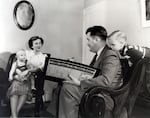On the morning of April 1, 1950, thousands of U.S. Census-takers fanned out across Oregon to count its approximately 1.5 million residents.
One enumerator stopped at a farm outside Monroe, Oregon — what was, at the time, one of the state’s largest cities, located 25 miles north of Eugene.
The census worker learned that the farm’s owner also made an income as a “milk tester,” while his wife took care of their children at home. Their two oldest sons worked the family farm, but they also earned paychecks as farmhands elsewhere, recording 30 hours each the week before.
The enumerator wrote all of this down by hand. This form and those of 46 million households nationwide would be tucked away, kept secret for the next seven decades.
Seventy-two years later, Dawn Carlile sat at her computer, refreshing her web browser until a few minutes past 9 p.m. Thursday [or, 12 a.m. Friday on the East Coast], when the U.S. Census released her family’s records for the first time.
“I knew my grandfather had had lots of different jobs over his lifetime,” Carlile said of her grandfather’s job as a milk tester. “It was interesting to see what he was doing in 1950. He went on to work in the poultry barn at [Oregon State University].”

A U.S. Census Bureau enumerator interviewing a mother with two children in 1950.
U.S. Census Bureau / U.S. Census Bureau
Congress passed a policy called the “72-Year Rule” in the 1970s as a means of protecting people’s private information. Every 10 years, records from census counts are released to the public, creating a new treasure trove of information for genealogists and family researchers.
The 1950 census was the country’s 17th decennial count and the last to be mostly conducted by door-to-door canvassers. While population and demographic estimates from this survey have long been public, the release of individual household records — like those from Carlile’s family — paint a picture of what life was like in Oregon.
Carlile teaches people how to research their family trees through the Oregon Genealogical Society.
“When you’re researching your family, [census records] show you at a place and time who was there and what they were doing, where they were living,” she said. “Sometimes that is the clue you need to go back further.”
Carlile says you can search for your family’s records at archives.gov. At that site, you can look up a household by name, or by their enumeration district — neighborhoods that are just large enough for an enumerator to go door-to-door in a day.
